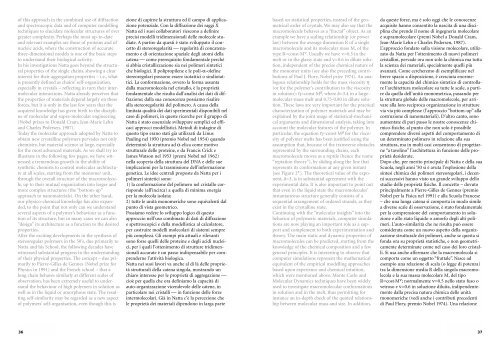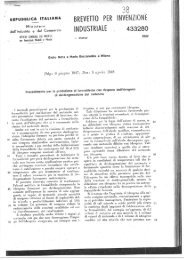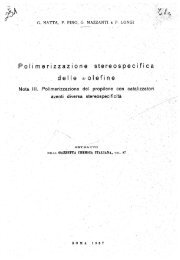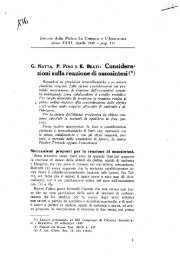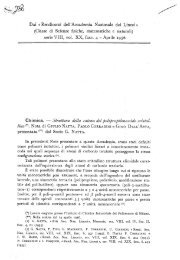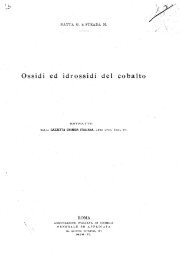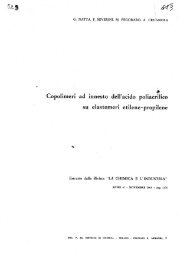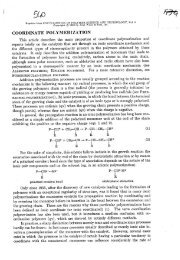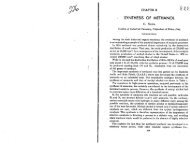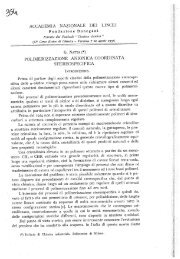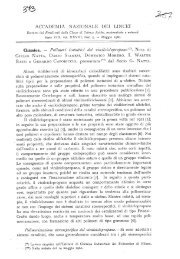n. 7, Ottobre 2003 - Giulio Natta
n. 7, Ottobre 2003 - Giulio Natta
n. 7, Ottobre 2003 - Giulio Natta
You also want an ePaper? Increase the reach of your titles
YUMPU automatically turns print PDFs into web optimized ePapers that Google loves.
of this approach in the combined use of diffraction<br />
and spectroscopic data and of computer modelling<br />
techniques to elucidate molecular structures of ever<br />
greater complexity. Perhaps the most up-to-date<br />
and relevant examples are those of proteins and of<br />
nucleic acids, where the construction of accurate<br />
three-dimensional models is one of the basic steps<br />
to understand their biological activity.<br />
In his investigations <strong>Natta</strong> goes beyond the structural<br />
properties of the single chains, showing a clear<br />
interest for their aggregation properties – i.e., what<br />
is presently defined as chains’ self-organization,<br />
especially in crystals – reflecting in turn their intermolecular<br />
interactions. <strong>Natta</strong> already perceives that<br />
the properties of materials depend largely on these<br />
forces, but it is only in the last few years that the<br />
acquired knowledge has given birth to the discipline<br />
of molecular and supra-molecular engineering<br />
(Nobel prizes to Donald Cram, Jean-Marie Lehn<br />
and Charles Pedersen, 1987).<br />
Today the molecular approach adopted by <strong>Natta</strong> to<br />
obtain new crystalline polymers pervades not only<br />
chemistry, but material science at large, especially<br />
for the most advanced materials. As we shall try to<br />
illustrate in the following few pages, we have witnessed<br />
a tremendous growth in the ability of<br />
synthetic chemists to control molecular architecture<br />
at all scales, starting from the monomer unit,<br />
through the overall structure of the macromolecule,<br />
up to their mutual organization into larger and<br />
more complex structures (the “bottom-up”<br />
approach to nanomaterials). On the other hand,<br />
our physico-chemical knowledge has also expanded,<br />
to the point that not only can we understand<br />
several aspects of a polymer’s behaviour as a function<br />
of its structure, but in many cases we can also<br />
“design” its architecture as a function to the desired<br />
properties.<br />
After the exciting developments in the synthesis of<br />
stereoregular polymers in the 50’s, due primarily to<br />
<strong>Natta</strong> and his School, the following decades have<br />
witnessed substantial progress in the understanding<br />
of their physical properties. The concept – due primarily<br />
to Pierre-Gilles de Gennes (Nobel prize for<br />
Physics in 1991) and the French school – that a<br />
long chain behaves similarly at different scales of<br />
observation, has been extremely useful to understand<br />
the behaviour of high polymers in solution as<br />
well as in the liquid or amorphous state. The resulting<br />
self-similarity may be regarded as a new aspect<br />
of polymers’ self-organisation, even though this is<br />
zione di capirne la struttura ed il campo di applicazione<br />
potenziale. Con la diffrazione dei raggi X<br />
<strong>Natta</strong> ed i suoi collaboratori riescono a definire<br />
precisi modelli tridimensionali delle molecole studiate.<br />
A partire da questi è stato sviluppato il concetto<br />
di stereoregolarità ⎯ regolarità di concatenamento<br />
e di orientazione spaziale degli atomi della<br />
catena ⎯ come prerequisito fondamentale perché<br />
si abbia cristallizzazione sia nei polimeri sintetici<br />
che biologici. Il polipropilene e le poli-α-olefine<br />
stereoregolari possono essere isotattici o sindiotattici.<br />
La conformazione, ovvero la forma assunta<br />
dalla macromolecola nel cristallo, è la proprietà<br />
fondamentale che risulta dall’analisi dei dati di diffrazione;<br />
dalla sua conoscenza possiamo risalire<br />
alla stereoregolarità del polimero. A causa della<br />
limitata qualità dei dati sperimentali disponibili nel<br />
caso di polimeri, in queste ricerche per il gruppo di<br />
<strong>Natta</strong> è stato essenziale sviluppare semplici ed efficaci<br />
approcci modellistici. Metodi di indagine di<br />
questo tipo erano stati già utilizzati da Linus<br />
Pauling nel 1950 (premio Nobel nel 1954) quando<br />
determinò la struttura ad α-elica come motivo<br />
strutturale delle proteine, e da Francis Crick e<br />
James Watson nel 1953 (premi Nobel nel 1962)<br />
nella scoperta della struttura del DNA e delle sue<br />
implicazioni per la trasmissione dell’informazione<br />
genetica. Le idee centrali proposte da <strong>Natta</strong> per i<br />
polimeri sintetici sono:<br />
1) la conformazione del polimero nel cristallo corrisponde<br />
(all'incirca) a quella di minima energia<br />
per la molecola isolata;<br />
2) tutte le unità monomeriche sono equivalenti dal<br />
punto di vista geometrico.<br />
Possiamo vedere lo sviluppo logico di questo<br />
approccio nell’uso combinato di dati di diffrazione<br />
e spettroscopici e della modellistica al calcolatore,<br />
per costruire modelli molecolari di sistemi sempre<br />
più complessi. Gli esempi più attuali e rilevanti<br />
sono forse quelli delle proteine e degli acidi nucleici,<br />
per i quali l’ottenimento di strutture tridimensionali<br />
accurate è un passo indispensabile per comprenderne<br />
l’attività biologica.<br />
<strong>Natta</strong> nei suoi lavori va anche al di là delle proprietà<br />
strutturali della catena singola, mostrando un<br />
chiaro interesse per le proprietà di aggregazione ⎯<br />
cioè per quella che ora definiamo la capacità di<br />
auto-organizzazione vicendevole delle catene, in<br />
particolare nei cristalli ⎯ in funzione delle forze<br />
intermolecolari. Già in <strong>Natta</strong> c’è la percezione che<br />
le proprietà dei materiali dipendono in larga parte<br />
based on statistical properties, instead of the geometrical<br />
order of crystals. We may also say that the<br />
macromolecule behaves as a “fractal” object. As an<br />
example we have a scaling relationship (or power<br />
law) between the average dimension R of a single<br />
macromolecule and its molecular mass M, of the<br />
type R=const⋅M ν . Usually we have ν=0.5 in the<br />
melt or in the glassy state and ν=0.6 in dilute solution,<br />
independent of the precise chemical nature of<br />
the monomer units (see also the preceding contributions<br />
of Paul J. Flory, Nobel prize 1974). An analogous<br />
relationship holds for the mass viscosity η<br />
(or for the polymer’s contribution to the viscosity<br />
in solution): η=const⋅M a ,where a=3.4 in a largemolecular-mass<br />
melt and 0.75-0.80 in dilute solution.<br />
These laws are very important for the practical<br />
characterization of polymer materials and may be<br />
explained by the joint usage of statistical-mechanical<br />
arguments and dimensional analysis, taking into<br />
account the molecular features of the polymer. In<br />
particular, the equation η=const⋅M a for the viscosity<br />
of polymer melts has been justified using the<br />
assumption that, because of the transverse obstacles<br />
represented by the surrounding chains, each<br />
macromolecule moves as a reptile (hence the name<br />
“reptation theory”), by sliding along the line that<br />
represents its conformation at any given instant<br />
[see Figure 2 ]. The theoretical value of the exponent,<br />
a=3, is in substantial agreement with the<br />
experimental data. It is also important to point out<br />
that even in the liquid state the macromolecules'<br />
instantaneous structure generally consists of a<br />
sequential arrangement of ordered strands, as they<br />
exist in the crystalline state.<br />
Continuing with the “molecular insights” into the<br />
behavior of polymeric materials, computer simulations<br />
are now playing an important role as a support<br />
and complement to both experimentation and<br />
theory. The main static and dynamic properties of<br />
macromolecules can be predicted, starting from the<br />
knowledge of the chemical composition and a few<br />
general principles. It is interesting to observe that<br />
computer simulations represent the mathematical<br />
equivalent of the empirical modelling approaches<br />
based upon experience and chemical intuition,<br />
which were mentioned above. Monte Carlo and<br />
Molecular Dynamics techniques have been widely<br />
used to investigate macromolecular conformations<br />
in solution and in the melt, thus permitting for<br />
instance an in-depth check of the quoted relationship<br />
between molecular mass and size. In addition,<br />
da queste forze, ma è solo oggi che le conoscenze<br />
acquisite hanno consentito la nascita di una disciplina<br />
che prende il nome di ingegneria molecolare<br />
e supramolecolare (premi Nobel a Donald Cram,<br />
Jean-Marie Lehn e Charles Pedersen, 1987).<br />
L’approccio fondato sulla visione molecolare, utilizzato<br />
da <strong>Natta</strong> per l’ottenimento di nuovi polimeri<br />
cristallini, pervade ora non solo la chimica ma tutta<br />
la scienza dei materiali, specialmente quelli più<br />
avanzati. Come cercheremo di esemplificare nel<br />
breve spazio a disposizione, è cresciuta enormemente<br />
la capacità del chimico sintetico di controllare<br />
l’architettura molecolare su tutte le scale, a partire<br />
da quella dell’unità monometrica, passando per<br />
la struttura globale delle macromolecole, per arrivare<br />
alla loro reciproca organizzazione in strutture<br />
via via più complesse (l’approccio “bottom-up” alla<br />
costruzione di nanomateriali). D’altro canto, sono<br />
aumentate di pari passo le nostre conoscenze chimico-fisiche,<br />
al punto che non solo è possibile<br />
comprendere diversi aspetti del comportamento di<br />
un determinato polimero in relazione alla sua<br />
struttura, ma in molti casi consentono di progettarne<br />
“a tavolino” l’architettura in funzione delle proprietà<br />
desiderate.<br />
Dopo che, per merito principale di <strong>Natta</strong> e della sua<br />
Scuola, negli anni ‘50 si è avuta l’esplosione della<br />
sintesi chimica dei polimeri stereoregolari, i decenni<br />
successivi hanno visto un grande sviluppo dello<br />
studio delle proprietà fisiche. Il concetto – dovuto<br />
principalmente a Pierre-Gilles de Gennes (premio<br />
Nobel per la Fisica nel 1991) e alla Scuola Francese<br />
– che una lunga catena si comporta in modo simile<br />
a diverse scale di osservazione, è stato fondamentale<br />
per la comprensione del comportamento in soluzione<br />
e allo stato liquido o amorfo degli alti polimeri.<br />
L’auto-similarità che ne risulta può essere<br />
considerata come un nuovo aspetto della organizzazione<br />
strutturale dei polimeri, anche se questa si<br />
fonda ora su proprietà statistiche, e non geometricamente<br />
determinate come nel caso dei loro cristalli.<br />
Si usa anche affermare che la macromolecola si<br />
comporta come un oggetto “frattale”. Nasce ad<br />
esempio una relazione di scala (o legge di potenza)<br />
tra la dimensione media R della singola macromolecola<br />
e la sua massa molecolare M, del tipo<br />
R=cost⋅M ν ; normalmente ν=0.5 nello stato fuso o<br />
vetroso e ν=0.6 in soluzione diluita, indipendentemente<br />
dalla precisa natura chimica delle unità<br />
monomeriche (vedi anche i contributi precedenti<br />
di Paul Flory, premio Nobel 1974). Una relazione<br />
36<br />
37


